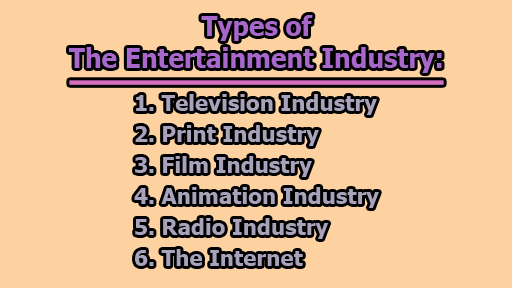The entertainment industry is a vast and dynamic realm that caters to the diverse tastes and preferences of audiences worldwide. It encompasses several sectors, each contributing uniquely to the global cultural landscape. In this article, we will explore the entertainment industry and types of the entertainment industry.
What is Entertainment Industry?
The entertainment industry refers to a broad spectrum of businesses and activities that create, produce, and distribute content with the primary purpose of providing enjoyment, amusement, and relaxation to audiences. This industry includes sectors such as film, television, music, print media, radio, gaming, and digital platforms, all of which contribute to the diverse array of entertainment options available to the public.
Types of the Entertainment Industry:
The entertainment industry is a multifaceted realm comprising various types, each catering to distinct preferences and engaging audiences in different ways. Here, we explore the major types of the entertainment industry:
- Television Industry:
- Broadcast and Cable Networks: Television networks play a pivotal role in shaping the entertainment landscape. They produce and broadcast a wide array of content, catering to diverse audience preferences. From major networks like ABC, NBC, and CBS to cable channels such as HBO and ESPN, these entities cover everything from news and sports to scripted dramas, reality shows, and documentaries. The traditional model of scheduled programming has been complemented by the rise of cable subscriptions, enabling viewers to choose specific channels or packages tailored to their interests.
- Streaming Services: The emergence of streaming services has revolutionized the television industry. Platforms like Netflix, Hulu, Amazon Prime, and Disney+ allow viewers to access content on-demand, binge-watching entire seasons of shows at their convenience. This shift has altered viewer habits, challenging traditional network models. Streaming services invest heavily in producing original content, leading to a surge in high-quality series and films exclusive to these platforms. This has given rise to a more globalized audience, transcending geographical boundaries.
- News and Information: Television serves as a crucial source for news and information dissemination. News channels provide real-time updates on current events, politics, and global affairs. Documentaries and educational programming contribute to the intellectual growth of the audience, exploring topics ranging from history and science to cultural phenomena. Educational channels, such as National Geographic and the History Channel, offer a blend of entertainment and learning, making television a multifaceted medium.
- Print Industry:
- Magazines: Magazines represent a diverse and vibrant segment of the print industry, catering to specific interests and demographics. Covering topics such as fashion, lifestyle, science, and entertainment, magazines provide readers with in-depth articles, interviews, and visually appealing content. Glossy fashion magazines like Vogue and lifestyle magazines such as National Geographic Traveler engage readers through captivating visuals and compelling narratives. The print format allows for a tangible and collectible reading experience.
- Newspapers: Newspapers continue to be a primary source of news for millions worldwide. They provide comprehensive coverage of local, national, and international events, offering in-depth analysis and investigative reporting. The print format, although challenged by digital alternatives, remains a trusted source for information. Newspapers play a critical role in shaping public opinion, providing a historical record of events, and fostering community engagement.
- Books: Books, a timeless form of entertainment, transport readers to different worlds, sparking imagination and intellectual exploration. Whether fiction or non-fiction, books offer a deep and immersive experience. Authors like J.K. Rowling, George R.R. Martin, and Chimamanda Ngozi Adichie have left an indelible mark on literature, creating stories that resonate across cultures. The print industry continues to be a haven for bibliophiles, with bookstores and libraries serving as cultural hubs.
- Film Industry:
- Hollywood and Global Cinema: The film industry, often synonymous with Hollywood, stands as a global powerhouse of entertainment. Hollywood produces blockbuster movies that dominate the international box office. However, the film industry is not confined to a single geographic location. Global cinema, including Bollywood in India, Nollywood in Nigeria, and various European film industries, contributes diverse narratives, cultural perspectives, and artistic innovation. Film festivals like Cannes and Sundance celebrate this diversity, providing a platform for independent filmmakers.
- Independent and Art Films: While Hollywood blockbuster films capture mainstream attention, independent and art films offer alternative storytelling. Independent filmmakers, often working with limited budgets, bring fresh and unique narratives to the screen. Film festivals dedicated to independent cinema, such as Sundance Film Festival, showcase groundbreaking work that challenges conventions and explores unconventional themes. Art films, characterized by their emphasis on artistic expression and experimental storytelling, contribute to the rich tapestry of cinematic artistry.
- Film Festivals: Film festivals play a crucial role in promoting artistic expression and innovation. Events like Cannes Film Festival, Sundance Film Festival, and Venice Film Festival provide a platform for filmmakers to showcase their work to a global audience. These festivals celebrate creativity, diversity, and the art of storytelling. Winning awards at prestigious film festivals can propel a film and its creators into the spotlight, influencing industry trends and public discourse on cinematic excellence.
- Animation Industry:
- 2D and 3D Animation: The Animation industry has undergone a remarkable transformation, transitioning from traditional hand-drawn 2D animation to sophisticated 3D animation and computer-generated imagery (CGI). Studios like Disney and DreamWorks have embraced these technological advancements, bringing characters and stories to life with stunning visual effects. The distinction between children’s animation and adult-oriented animation has blurred, allowing the industry to explore a wide range of themes and genres, appealing to audiences of all ages.
- Pixar, Disney, and Studio Ghibli: Studios such as Pixar, Disney, and Studio Ghibli have played a pivotal role in elevating animation to an art form. Pixar’s mastery of storytelling and animation technology has given rise to beloved films like “Toy Story” and “Finding Nemo.” Disney’s timeless classics continue to enchant new generations, while Studio Ghibli, with its unique Japanese perspective, has created emotionally resonant and visually captivating animated masterpieces like “Spirited Away” and “My Neighbor Totoro.”
- Television Animation: Animation is not limited to the big screen; it has also made a significant impact on television. Animated series cater to a broad audience, with shows ranging from children’s cartoons to sophisticated adult-oriented animations. Iconic series like “The Simpsons,” “South Park,” and “Avatar: The Last Airbender” showcase the versatility of the medium, tackling social issues, humor, and complex storytelling through animated characters.
- Radio Industry:
- Music Radio: Music radio stations remain influential in introducing new artists, genres, and songs to the public. DJs curate playlists, creating an immersive experience for listeners. Music radio plays a pivotal role in shaping musical trends, fostering a sense of community among fans, and providing a platform for both established and emerging artists.
- Talk Radio and Podcasts: Beyond music, talk radio and podcasts have gained prominence, offering a platform for discussions, interviews, and storytelling. Podcasts, in particular, have democratized content creation, allowing individuals and experts to share their perspectives on a myriad of topics. From true crime podcasts to informative discussions on science, politics, and pop culture, this format has become a popular source of entertainment and knowledge.
- Niche Radio Stations: Specialized radio stations cater to specific genres and interests, creating a diverse radio landscape. Whether it’s jazz, classical music, talk shows on niche topics, or regional programming, these stations provide tailored content for audiences with specific preferences. Niche radio stations contribute to the preservation of cultural and musical diversity.
- The Internet:
- Streaming Platforms: The Internet has revolutionized content consumption through streaming platforms. Services like Netflix, Hulu, and Amazon Prime offer a vast library of on-demand content, allowing users to watch movies, TV series, and documentaries at their convenience. The subscription-based model has disrupted traditional cable and satellite television, providing a more personalized and flexible viewing experience.
- Social Media: Social media platforms such as Instagram, Twitter, Facebook, and TikTok have become integral to the entertainment landscape. They connect fans with celebrities, allow for real-time interactions, and facilitate the viral spread of trends and content. Social media has become a platform for fan communities, breaking news, and shaping public opinion on various cultural phenomena.
- Online Gaming: The gaming industry, a significant part of online entertainment, has witnessed exponential growth. Online gaming platforms and esports have transformed gaming into a mainstream form of entertainment. Massive multiplayer online games (MMOs) like “World of Warcraft” and competitive esports leagues attract millions of players and spectators worldwide, solidifying gaming’s position as a major cultural phenomenon.
In conclusion, the entertainment industry, in all its diverse forms, continues to shape our cultural experiences and reflections. From the traditional allure of television and print to the cutting-edge innovations in film, animation, radio, and the internet, each sector contributes uniquely to the rich tapestry of global entertainment.
As technology advances and audience preferences evolve, these industries will undoubtedly undergo further transformations. Yet, the core essence of entertainment – the ability to captivate, inspire, and connect – remains a constant driving force. Embracing the multifaceted nature of the entertainment industry allows us to appreciate the myriad ways in which it enriches our lives and contributes to the ever-evolving cultural landscape.
Frequently Asked Questions (FAQs):
What is the entertainment industry?
The entertainment industry is a diverse and expansive sector that encompasses various forms of media and activities aimed at providing enjoyment and amusement to audiences. It includes sectors such as film, television, music, print media, radio, gaming, and digital platforms.
What are the major types of the entertainment industry?
The major types of the entertainment industry include the Television industry, Print industry, Film industry, Animation industry, Radio industry, and the Internet.
How has the television industry evolved over the years?
The television industry has evolved from traditional broadcast networks to the rise of cable TV and, more recently, streaming services. On-demand content and a diverse range of genres, from news to scripted dramas, contribute to its dynamic nature.
What role does the print industry play in entertainment?
The print industry, comprising magazines, newspapers, and books, plays a crucial role in storytelling, journalism, and knowledge dissemination. Magazines cater to diverse interests, newspapers provide news and analysis, and books offer immersive, tangible entertainment experiences.
How has the film industry impacted global culture?
The film industry, led by Hollywood and global cinema, has left a profound impact on global culture. Blockbuster films, independent productions, and art-house films contribute to cultural diversity and shape discussions on various themes.
What distinguishes the Animation industry?
The Animation industry involves the creation of animated content using techniques such as 2D and 3D animation. Studios like Pixar, Disney, and Studio Ghibli have elevated animation to an art form, producing visually stunning and emotionally resonant content.
What is the significance of the Radio industry in the modern era?
Despite technological advances, the Radio industry remains relevant, providing an auditory experience through music, talk shows, and podcasts. It introduces new music, fosters community through discussions, and offers niche programming for diverse interests.
How has the Internet impacted the entertainment landscape?
The Internet has revolutionized entertainment through streaming platforms like Netflix, social media platforms such as Instagram and TikTok, and the booming online gaming industry. It has democratized content creation and consumption, connecting audiences globally.
What is the role of social media in the entertainment industry?
Social media platforms serve as crucial tools for connecting fans with celebrities, facilitating real-time interactions, and driving trends. They play a pivotal role in shaping public opinion and fostering fan communities.
How has online gaming become a part of the entertainment industry?
Online gaming has evolved into a major entertainment sector, with massive multiplayer online games (MMOs) and esports gaining widespread popularity. It provides interactive and competitive experiences, engaging millions of players globally.

Assistant Teacher at Zinzira Pir Mohammad Pilot School and College










